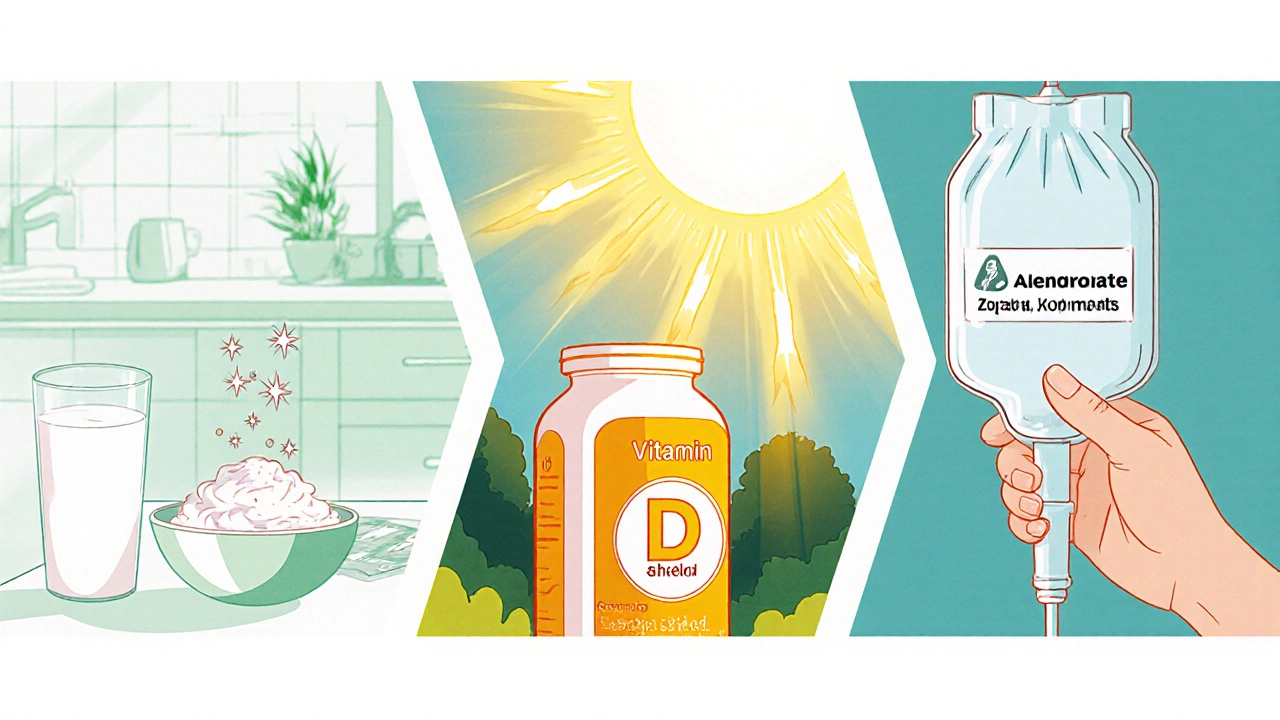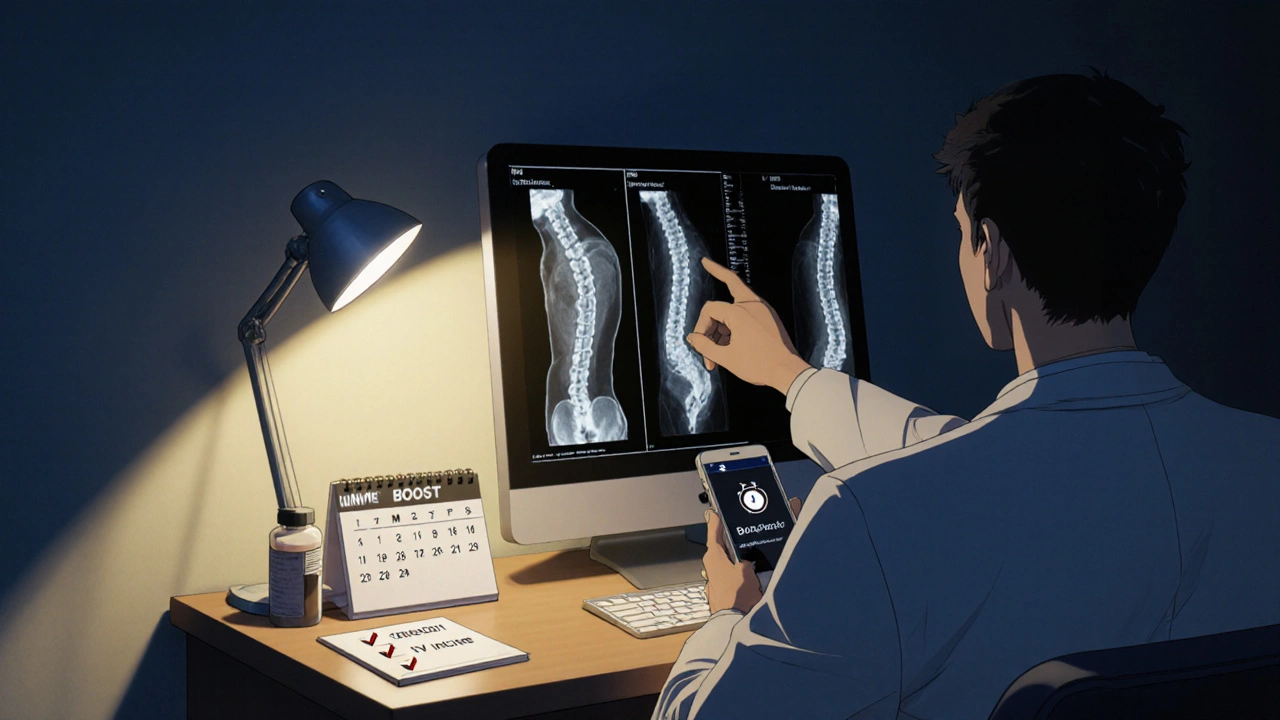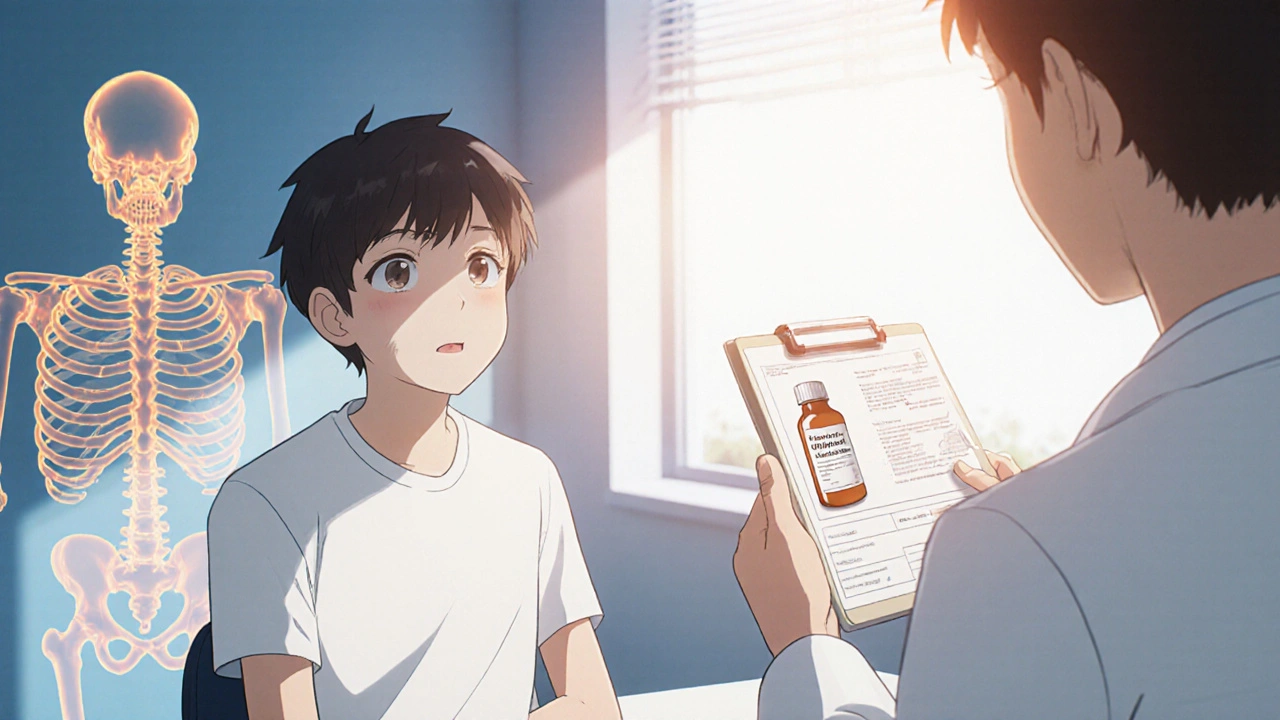Steroid-Induced Osteoporosis Risk Calculator
Risk Assessment Tool
This calculator estimates your fracture risk based on steroid dose and treatment duration using guidelines from the American College of Rheumatology (2023).
Your Fracture Risk Assessment
Prevention Checklist
- Calcium: 1,000-1,200mg/day in split doses
- Vitamin D: 600-800IU/day (1,000IU if <30 ng/mL)
- Baseline DXA before starting steroids
- Follow-up DXA at 12 months
When a doctor prescribes long‑term steroids, the last thing most patients think about is bone loss. Yet the steroid‑induced osteoporosis risk can rise 5‑ to 17‑fold within the first few months. The good news? A three‑step plan-adequate calcium, vitamin D, and the right bisphosphonate-covers over 80% of the fracture‑prevention gap.
Why Steroids Attack Your Skeleton
Glucocorticoids blunt bone formation by killing off osteoblasts and shortening their lifespan, accounting for roughly 70% of the bone loss seen in Glucocorticoid‑induced osteoporosis (a secondary osteoporosis caused by chronic steroid therapy). At the same time, they boost osteoclast activity, adding another 30% of bone loss. The combined assault starts as early as 3‑6 months after the first dose of ≥2.5 mg prednisone‑equivalent per day, with vertebral fractures reported in 12% of patients receiving ≥7.5 mg daily within the first year.
Step 1: Calcium - The Bedrock Nutrient
All guidelines from the American College of Rheumatology (2023) agree: Calcium (the mineral that provides the structural matrix for bone) should be 1,000-1,200 mg daily for anyone starting a steroid course of three months or longer. A split dose (e.g., 500 mg with breakfast and 500 mg with dinner) maximizes absorption because the gut can only handle about 500 mg at a time.
Practical tip: use a combination of dairy (milk, cheese, yogurt) and fortified plant milks if you’re lactose intolerant. For patients with kidney stones, keep the total daily calcium under 1,500 mg and monitor urinary calcium excretion.
Step 2: Vitamin D - The Sunshine Shield
Vitamin D drives calcium absorption in the gut. The ACR recommends 600-800 IU per day for all adults on steroids, and 800-1,000 IU for those whose serum 25‑OH‑vitamin D is under 30 ng/mL. A single 50,000 IU capsule once a month can quickly replenish levels in deficient patients.
When you combine calcium with adequate vitamin D, you achieve a 30‑40% reduction in early vertebral fractures compared with calcium alone-a finding echoed in the 2020 Cochrane review of 27 RCTs.
Step 3: Bisphosphonates - The Pharmacologic Power‑Tool
Bisphosphonates stick to bone mineral and inhibit osteoclasts, directly countering the resorption side of steroid damage. The 2023 Endocrine Reviews consensus places them as first‑line therapy for anyone ≥40 years old on prednisone ≥2.5 mg/day for at least three months.
Oral Options
- Alendronate (70 mg taken weekly) - showed a 3.7% lumbar spine BMD gain after 12 months in the FOSIT trial.
- Risedronate (35 mg weekly) - comparable BMD benefits with a slightly lower gastrointestinal (GI) irritation profile.
Key administration rule: stay upright for at least 30 minutes, drink a full glass of water, and avoid any food or meds within 30 minutes of the dose. Failure to follow this leads to the 15‑30% GI upset rate reported in multiple GIOP trials.
Intravenous Choices
- Zoledronic acid (5 mg IV once a year) - outperformed oral bisphosphonates by 4.1% lumbar spine BMD gain in a 2020 RCT and reduced hip fractures by 41%.
IV delivery bypasses GI issues and improves adherence dramatically; the ZEUS trial showed a 38% higher completion rate versus weekly oral dosing.
When Bisphosphonates Aren’t Ideal
Renal impairment (eGFR < 30 mL/min) and esophageal disease are red flags. In those cases, consider an osteoanabolic agent such as Teriparatide (20 µg subcutaneous daily). The 2007 ACTIVE study showed a 0.6% vertebral fracture incidence versus 6.1% with alendronate over 18 months-an order‑of‑magnitude improvement-but at roughly ten times the cost.
Denosumab (60 mg SC every 6 months) sits in the middle: a 79% vertebral fracture risk reduction and no renal dosing restrictions, though it requires lifelong administration to avoid rebound bone loss after discontinuation.

Choosing the Right Agent - A Quick Decision Tree
1. Age ≥ 40 and steroids ≥ 2.5 mg/day for ≥ 3 months? → Start calcium + vitamin D + oral bisphosphonate. 2. History of GI ulcer, esophagitis, or poor oral adherence? → Switch to IV zoledronic acid. 3. eGFR < 30 mL/min or contraindication to bisphosphonates? → Consider teriparatide or denosumab. 4. High fracture risk (prior fragility fracture, T‑score ≤ ‑2.5, FRAX ≥ 20%)? → Teriparatide preferred if budget allows; otherwise, use the most potent bisphosphonate (zoledronic acid) and monitor BMD every 6 months.
Monitoring: Scans, Scores, and Switches
Baseline DXA (dual‑energy X‑ray absorptiometry for bone mineral density) of lumbar spine and hip is mandatory before starting therapy. Repeat at 12 months; a >5% loss signals the need to escalate - either intensify bisphosphonate dosing or move to an anabolic agent.
Use the FRAX calculator (with glucocorticoid input) to estimate 10‑year major osteoporotic fracture risk. If the result crosses the 20% threshold, the guidelines shift from “optional” to “strong” recommendation for pharmacologic treatment.
Adherence Hacks - Turning Prescription into Habit
- Set a daily alarm labeled “Bone Boost.”
- Pair the pill with a daily ritual (e.g., morning coffee).
- Provide patients with a simple handout that illustrates upright‑posture dosing.
- Consider annual IV zoledronic acid for those who miss >30% of oral doses.
Education matters: a 2022 JAMA Internal Medicine study found only 19.3% of eligible patients received any prophylaxis within three months of steroid start. Simple counseling can close that gap.

Practical Checklist for Clinicians
| Item | What to Do |
|---|---|
| Baseline labs | 25‑OH‑vitamin D, serum calcium, creatinine, eGFR |
| Imaging | DXA of lumbar spine & hip |
| Supplements | Calcium 1,000-1,200 mg + Vitamin D 600-800 IU (adjust if deficient) |
| First‑line drug | Oral alendronate 70 mg weekly (or risedronate 35 mg weekly) |
| Alternative drug | IV zoledronic acid 5 mg yearly if GI issues or adherence problems |
| High‑risk escalation | Teriparatide 20 µg daily or denosumab 60 mg q6 mo |
| Follow‑up | DXA at 12 months; review adherence and side effects every 3 months |
Common Pitfalls and How to Avoid Them
Pitfall 1: Forgetting to start calcium/vitamin D at the same time as steroids. Fix: Place supplement orders in the same electronic prescription bundle.
Pitfall 2: Ignoring renal function when prescribing oral bisphosphonates. Fix: Check eGFR; if <30 mL/min, skip oral bisphosphonates.
Pitfall 3: Discontinuing bisphosphonate after 3 years without reassessment. Fix: Re‑evaluate BMD; consider a drug holiday only if BMD stable and fracture risk low.
Future Directions - What’s on the Horizon?
New anabolic agents like abaloparatide and sequential regimens (teriparatide followed by zoledronic acid) are being tested in the SWAN study, promising up to a 25% greater BMD gain. Cost barriers are the main obstacle, but as biosimilars enter the market, we may see these options move from niche to mainstream by 2030.
Bottom Line
Preventing steroid‑induced osteoporosis isn’t a mystery-it’s a matter of three simple actions: give enough calcium, correct vitamin D, and start the right bisphosphonate (or an anabolic agent for high‑risk patients). Pair those steps with baseline DXA, regular monitoring, and clear patient education, and you’ll slash fracture rates dramatically.
How much calcium should a patient on steroids take?
The American College of Rheumatology recommends 1,000-1,200 mg of elemental calcium per day, split into two doses for optimal absorption.
Is vitamin D supplementation really necessary?
Yes. Vitamin D boosts calcium absorption and, when combined with calcium, reduces early vertebral fractures by about a third compared with calcium alone.
When should I choose an IV bisphosphonate over an oral one?
Prefer IV zoledronic acid if the patient has gastrointestinal intolerance, poor oral adherence, or a history of esophageal disease. It also gives better hip‑fracture protection.
What are the red‑flag lab values before starting bisphosphonates?
Check serum calcium (keep it in the normal range), vitamin D (>30 ng/mL), and renal function (eGFR ≥30 mL/min). Low calcium or severe renal impairment require dose adjustments or alternative agents.
How often should bone density be re‑checked?
A baseline DXA before starting steroids, then repeat at 12 months. If BMD loss exceeds 5% or the patient experiences a fracture, reassess sooner and consider therapy escalation.


Don't be fooled by the glossy pamphlets – the real agenda behind bisphosphonates is to keep the pharmaceutical giants cashing in while you stay dependent on endless refills. The calcium‑vitamin D duo is just a sugar‑coated distraction, and the studies they tout are riddled with hidden conflicts of interest. If you truly want to protect your skeleton, focus on lifestyle, weight‑bearing exercise, and question every pill they push on you.
It's fascinating how a simple trio of calcium, sunshine vitamin, and a bone‑shield drug can change the fate of patients on steroids. I love the idea that we can actually prevent a silent killer before it sneaks up. Remember, even tiny steps like a glass of fortified milk or a daily walk in the sun can make a world of difference. Keep spreading the word, folks – the tiny changes add up!
Sorry for the typo, but the hope is real.
First, let’s break down the physiology: glucocorticoids suppress osteoblast activity and simultaneously boost osteoclast resorption, creating a perfect storm for bone loss. This dual mechanism means that a single intervention won’t suffice; we need a multi‑pronged approach to restore balance. Calcium supplementation of 1,000‑1,200 mg per day replenishes the mineral matrix, but without adequate vitamin D, absorption stalls at roughly 30‑40 % of its potential. That’s why the ACR recommends 600‑800 IU daily for most adults, rising to 800‑1,000 IU for those with serum 25‑OH‑vitamin D below 30 ng/mL. A one‑time 50,000 IU loading dose can rapidly correct severe deficiency, but maintenance is key.
Next, bisphosphonates. Oral alendronate at 70 mg weekly has demonstrated a 3.7 % lumbar spine BMD gain over 12 months, while risedronate offers a comparable profile with slightly fewer gastrointestinal complaints. The administration rule-remain upright for 30 minutes, take with a full glass of water, and avoid food/meds-cannot be overstated; non‑adherence is the leading cause of esophageal irritation and reduced efficacy. For patients who struggle with oral regimens, intravenous zoledronic acid 5 mg yearly bypasses the gut entirely and has outperformed oral agents with a 4.1 % BMD increase and a 41 % reduction in hip fractures in the ZEUS trial.
Monitoring is equally crucial. Baseline DXA of the lumbar spine and hip sets a reference point, and a repeat scan at 12 months detects early loss; a >5 % decline should trigger therapy escalation. The FRAX calculator, adjusted for glucocorticoid dose, provides a 10‑year fracture risk estimate-once you cross the 20 % threshold, the guidelines shift from optional to strong recommendation for pharmacologic intervention.
Adherence hacks can’t be ignored. Pairing the weekly pill with a morning coffee, setting a daily alarm labeled “Bone Boost,” and providing patients with a simple handout illustrating upright dosing dramatically improve compliance. In the real world, only 19.3 % of eligible steroid users receive any prophylaxis within three months, a gap we can close with consistent counseling and reminder systems.
Finally, special populations need tailored strategies. Those with eGFR below 30 mL/min or severe esophageal disease should avoid oral bisphosphonates; options include teriparatide, albeit costly, or denosumab, which carries no renal dosing restrictions but demands lifelong administration to prevent rebound bone loss after cessation. By integrating calcium, vitamin D, appropriate bisphosphonate choice, vigilant monitoring, and patient‑centered adherence tools, we can effectively plug the fracture‑prevention gap in steroid‑induced osteoporosis.
The so‑called "scientific consensus" is a veil for hidden agendas, and the bone‑protecting drugs are no exception. They want you to believe that a monthly injection is safer, but the long‑term consequences are still a mystery. Remember, every new molecule brings a fresh set of unseen side effects.
Bone health is a battle, and bisphosphonates are the sharpest sword.
Let's get moving! If you’re on steroids, set a reminder and take your calcium with breakfast. Pair that with a short walk or some body‑weight squats to stimulate bone formation. Consistency beats perfection, so even if you miss a dose, get back on track tomorrow.
This checklist reads like a textbook-clear, crisp, and absolutely essential. Skipping the baseline labs is a rookie mistake that can lead to disastrous outcomes. Follow the protocol, and you’ll keep those silent fractures at bay.
American patients get the best guidelines, but the rest of the world seems stuck with outdated advice. Our doctors should push for the latest bisphosphonate protocols, not settle for half‑measures. The data is crystal clear-IV zoledronic acid saves more lives.
Everyone’s hailing the three‑step plan, but what about those who can’t tolerate any bisphosphonate? The drama of “one size fits all” ignores the nuanced reality of renal disease and gastrointestinal woes. Let’s stop the hype and talk about real alternatives.
The moral imperative here is undeniable: clinicians owe their patients a comprehensive regimen, not a half‑hearted suggestion. By prescribing calcium and vitamin D without addressing the inevitable bone loss from steroids, we commit a subtle form of negligence. The guidelines exist for a reason, yet many physicians treat them as optional reading material. One must ask: is it not a dereliction of duty to ignore the established evidence that bisphosphonates dramatically reduce fracture risk? Moreover, the ethical burden intensifies when patients are left to navigate complex dosing instructions on their own. In practice, the upright‑posture rule for oral bisphosphonates is often glossed over, leading to preventable GI complications. This oversight is not merely a slip; it reflects a deeper complacency within the medical community. Therefore, a steadfast commitment to the full three‑step protocol is not just advisable-it is a moral necessity.
Yo, this checklist is straight fire, but don't forget the real talk-if you don't keep up with the meds, you're just asking for a broken bone. The whole vitamin D thing is easy, just get some sunshine or pop a pill. Also, check your kidney numbers before diving into bisphosphonates. Stay on top of it.
Another day, another list. If you’re lazy like me, just grab a calcium supplement and hope for the best. The rest is optional, I guess.